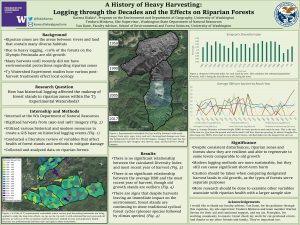A History of Heavy Harvesting: Logging through the Decades and the Effects on Riparian Forests
The Olympic Peninsula has a lush environment, and notably, riparian zones, the areas between rivers and dry land, are imperative for many healthy ecosystems. However, the peninsula also has a strong logging industry, which has historically disrupted riparian zones through intensive clear-cuts. It is important to understand how these forest stands have recovered after logging events to ensure a healthy ecosystem and better protect riparian zones that may still be recovering. The purpose of this research is to analyze how forests in riparian zones within the Olympic Experimental State Forest (OESF) have recovered after historical logging events. To accomplish this task, I created a map detailing historical logging in 16 watersheds within the OESF. Then, I gathered data on the health of forests in OESF’s riparian zones, such as the count of live and dead trees and biodiversity. This was followed by an analysis of these variables in relation to the most recent year of harvest. Many riparian forests that were harvested from 1940 onward show signs of recovery, such as natural forest successional patterns and high biodiversity of trees. Recently harvested areas had the lowest biodiversity, but they still show signs of expected forest succession. Areas that have been harvested should continue to be monitored for changes in regrowth, but these results show that best management practices meant to protect forests in Washington are working. Identifying areas that have recovered or need aid can also help in focusing restoration efforts where it is needed most.
